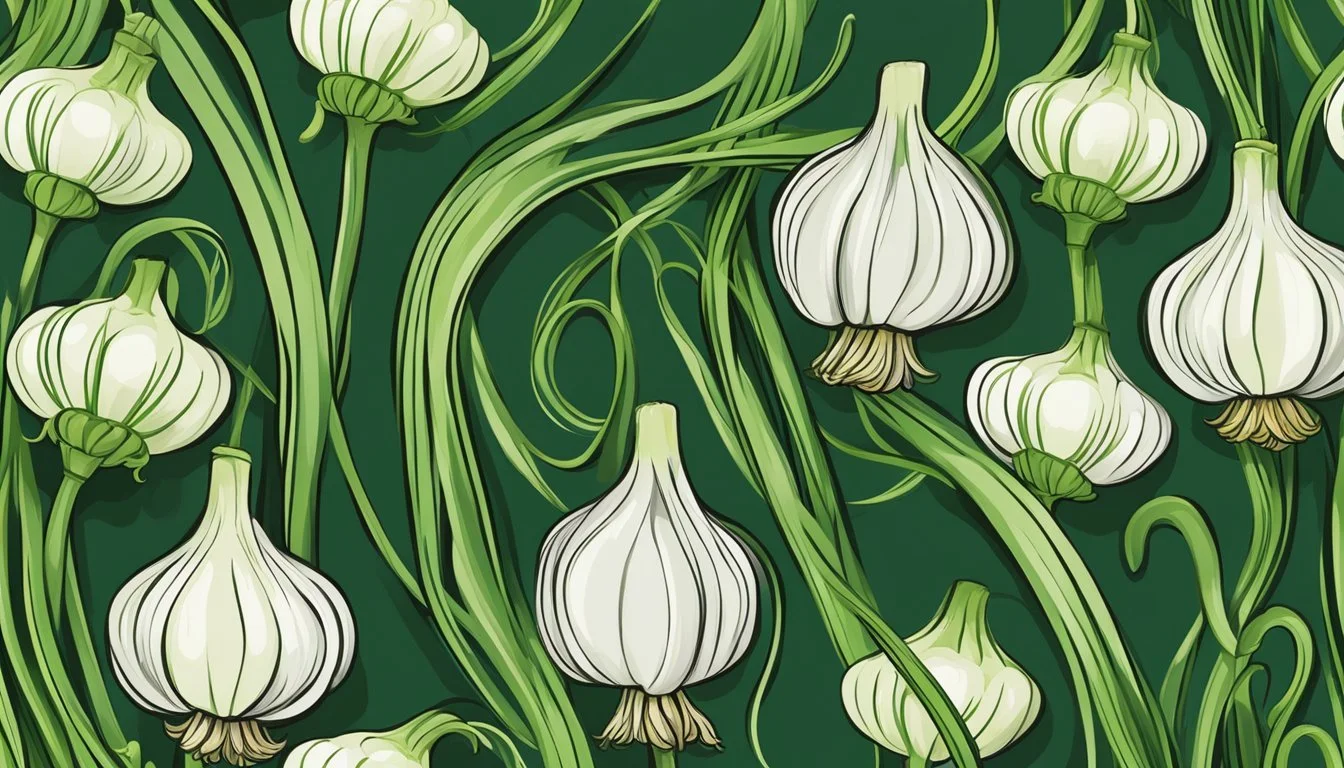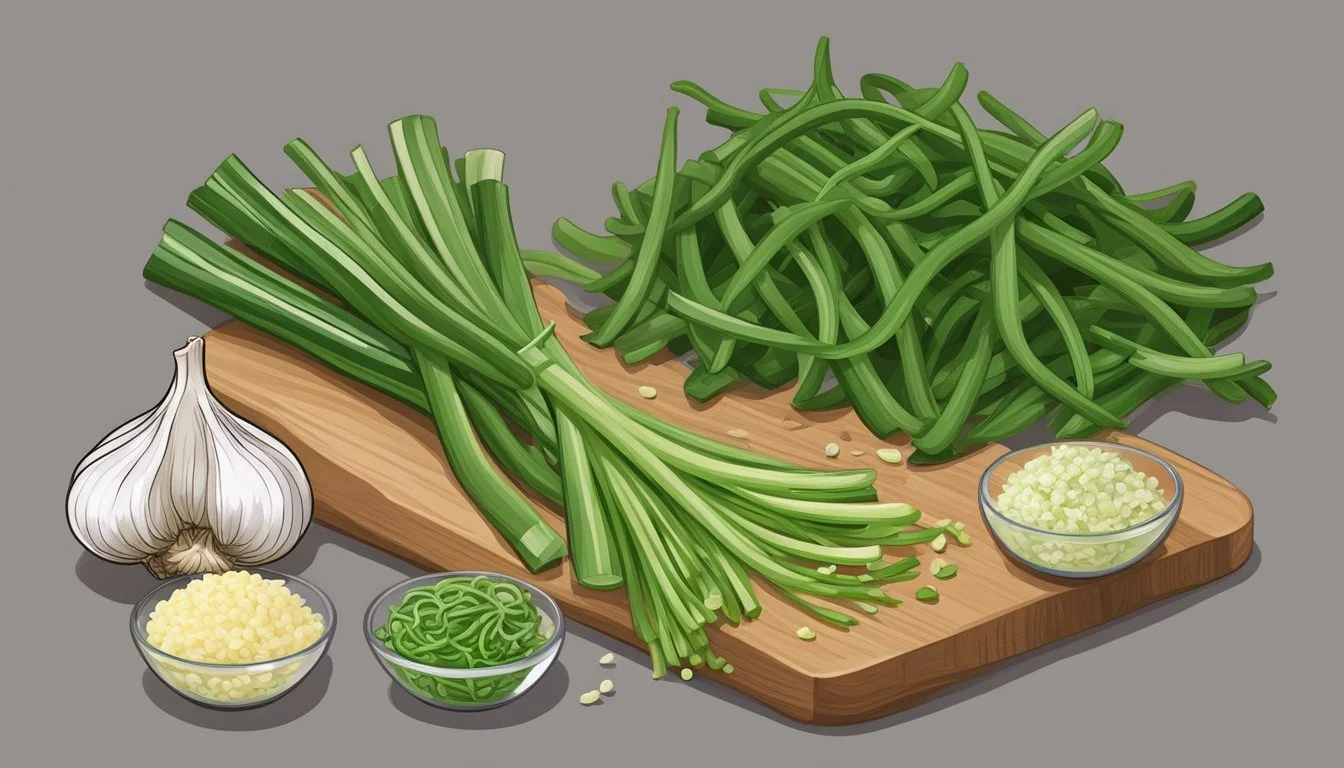Garlic Scapes Substitutes
Best Alternatives for Cooking
Garlic scapes are a unique ingredient that add a mild, garlicky flavor to various dishes, making them a favorite among home cooks and chefs alike. However, if you can't find garlic scapes, there are several substitutes that can effectively mimic their taste and texture. Garlic chives are one of the best substitutes for garlic scapes, offering a similar flavor profile and can be easily found in most grocery stores.
For those looking for alternatives, scallions (green onions) can be used to provide a strong onion flavor, which works well in many recipes that call for garlic scapes. If you prefer a bit of heat, jalapeños can also be used, substituting 4-6 garlic scapes for every fresh garlic clove. Each substitute brings its own unique twist to the dishes, allowing for some flexibility and creativity in the kitchen.
Whether sautéed, grilled, or used in pestos and sauces, these substitutes can help maintain the integrity of your recipes when garlic scapes are not available. Understanding the best substitutes ensures that your dishes do not lose their intended flavor, keeping your culinary creations both delicious and flavorful.
Understanding Garlic Scapes
Garlic scapes are the green, tender flower stalks that grow from the garlic bulb.
They are typically slender and curly, harvested before the bulb has fully matured. This helps the garlic plant focus its energy on growing a larger bulb. Garlic scapes are part of the allium family, which includes onions, leeks, and chives.
Taste and Aroma
Garlic scapes have a milder, fresher taste compared to the more pungent garlic cloves. When used in cooking, they provide a subtle garlicky flavor that is less intense but highly aromatic. Farmers and chefs appreciate their versatility and the delicate nuances they add to dishes.
Usage in Cooking
Garlic scapes can be used in various ways:
Sautéed: Perfect for stir-fries and pastas.
Raw: Thinly sliced in salads.
Pesto: Blended into a garlicky green pesto.
Their tender texture allows them to be used similarly to garlic chives or green garlic shoots.
Availability
Garlic scapes are typically available in late spring and early summer. They are often found at farmers' markets and specialty grocery stores. Freshness is key, and their seasonality makes them a prized ingredient during the harvest months.
Nutritional Value
Just like garlic bulbs, garlic scapes are nutritious. They contain vitamins A and C, as well as fiber. Their mild, herbaceous flavor combined with their nutritional benefits makes them a valuable addition to a wide range of culinary creations.
Common Uses of Garlic Scapes
Garlic scapes are versatile ingredients, often incorporated into diverse dishes due to their mild garlic flavor and tender texture. They can be used in several cooking methods and as garnishes to elevate the presentation of various meals.
In Cooking
Garlic scapes can be sautéed in oil or butter until tender and slightly browned, enhancing their natural sweetness. This method is perfect for stir-fries or as a simple side dish.
They are great for grilling. Tossed in oil and seasoned, grilled scapes add a smoky flavor, making them an excellent addition to summer barbecues.
They are also commonly used in pesto recipes. Blended with nuts, Parmesan cheese, and olive oil, garlic scapes make a delicious and unique pesto sauce.
Incorporate garlic scapes into soups and stews, adding a mild garlic flavor. They can be added raw to salads for a crunchy texture and subtle garlic taste.
Including them in marinades and dressings enhances the flavor profile, making them a remarkable addition to these preparations.
As Garnish
As a garnish, garlic scapes offer both flavor and visual appeal. Finely chopped scapes can be sprinkled over dishes to add a mild garlic taste without overpowering other flavors.
They can be sliced into thin rings and used to top soups and salads, providing a pop of color and a slight crunch. They work well as a garnish for roasted meats or fish, adding a fresh, herbal note.
Garlic scapes can be pickled and used as a tangy garnish for sandwiches, burgers, or charcuterie boards, adding both texture and a zesty flavor that complements various dishes.
Integrating garlic scapes as a garnish can elevate the overall dining experience, making dishes more appealing and flavorful.
Choosing Substitute Ingredients
When selecting a substitute for garlic scapes, consider factors such as freshness, crunch, suitability for various cooking methods, and the ability to provide an aromatic flavor. Different substitutes can bring unique qualities to your dish, depending on what you are looking to achieve.
For Freshness and Crunch
Garlic Chives are a great option if you need a fresh and crunchy substitute for garlic scapes. They resemble scapes in texture and impart a mild garlic flavor, making them suitable for salads and garnishes. Green Onions (also known as Scallions) can also be used to maintain a crunchy texture while adding a mildly pungent onion-garlic blend.
Leeks can be another alternative for freshness and texture. Although they have a more subtle onion flavor, their stalks are firm and provide a satisfying bite. Including Shallots finely chopped can also offer a delicate crunch, though they are more commonly known for their slightly sweet onion flavor.
For Cooking Applications
When it comes to cooking with substitutes, Green Onions are versatile and can be sautéed, grilled, or used in stir-fries.
Garlic Chives perform well in cooked dishes, retaining a bit of their bite. Leeks are excellent for soups and stews, adding a gentle onion flavor without overpowering other ingredients. Shallots can be caramelized or used in sauces to bring depth and complexity to the dish.
For grilling, Green Onions can mimic the charred and tender qualities of grilled garlic scapes. Garlic Powder or Flakes can be included for an easy way to introduce garlic notes, especially when fresh ingredients are unavailable. This is particularly useful in dressings, marinades, and dry rubs.
For Aromatic Flavor
If the goal is to enhance the aromatic quality of your dish, Garlic Chives are an ideal substitute. They offer a bouquet of mild garlic fragrance that pairs well with many culinary applications.
Scallions provide a sweet, oniony aroma that complements both raw and cooked dishes. For a richer aromatic experience, Shallots deliver a complex blend of sweetness and pungency, making them suitable for sauces and dressings. Leeks can offer a subtle yet aromatic onion-like perfume that integrates well with soups and casseroles.
Choosing the right substitute depends on the specific requirements of your recipe and desired outcome. Each of these alternatives offers unique characteristics that can enhance your dish in different ways.
Substitute Options
Garlic scapes can be substituted with various kitchen staples that bring their distinct flavors to dishes. Options include green onions, chives, garlic chives, shallots, and different commercial garlic products.
Green Onions and Scallions
Green onions and scallions are excellent substitutes for garlic scapes. They offer a mild onion flavor that complements a variety of dishes. Scallions can be used raw in salads or cooked in stir-fries.
Both their white and green parts are edible, making them versatile. For best results in cooking, sauté scallions briefly to maintain their tender texture. They're easily available in grocery stores, making them a practical choice.
Chives and Garlic Chives
Chives, both common and garlic varieties, are another great substitution. Regular chives have a subtle onion flavor, while garlic chives offer a mild garlic taste, somewhat similar to garlic scapes.
Chives work well in garnishes, soups, and dressings. When using garlic chives, bear in mind they are slightly more potent. Both types can be finely chopped and used fresh or cooked, adding a bright green color and fresh flavor to recipes.
Shallots and Leeks
Shallots and leeks provide a more sophisticated alternative. Shallots have a nuanced, sweet onion flavor with a hint of garlic. They can be used in dressings, sauces, and cooked dishes.
Leeks have a milder, sweeter onion flavor and work well in soups and stews. Both ingredients best mimic the texture of garlic scapes when finely chopped. Sautéing them gently can enhance their natural flavors.
Onion Varieties
Different onion varieties can also replace garlic scapes. Yellow, white, and red onions vary in strength and sweetness, with yellow onions being the most robust.
These onions can be sautéed, caramelized, or used raw, depending on the dish. Red onions add a sharp, tangy flavor suitable for salads and salsas. Adjusting the quantity used and the cooking method will help balance their stronger flavors.
Commercial Garlic Products
For a more direct garlic flavor, commercial products like minced garlic, garlic powder, granulated garlic, garlic salt, garlic oil, and jarred garlic are available.
Minced garlic is a convenient, strong substitute, especially useful for garlic-heavy recipes. Garlic powder and granulated garlic provide a concentrated flavor, ideal for dry rubs and marinades. Jarred garlic offers a shelf-stable option, whereas garlic oil can be used for infusing dishes with garlic essence. Adjusting the quantity is key to avoiding overpowering the dish.
Culinary Applications and Recipes
Garlic scapes can be employed in diverse culinary applications to enrich recipes with their mild garlic flavor. They can be used fresh, sautéed, grilled, or pickled, making them versatile for various dishes. Below are detailed applications for sauces, marinades, soups, main dishes, and sides.
Sauces and Pestos
Garlic scapes make excellent additions to sauces and pestos. In pestos, they replace traditional garlic, delivering a milder, fresher flavor. Blend garlic scapes with basil, pine nuts, parmesan cheese, olive oil, and lemon juice for a vibrant pesto.
For sauces, finely chop garlic scapes and sauté them in olive oil before incorporating tomatoes, cream, or cheese. This can enhance pasta sauces or accompanying vegetable dishes such as asparagus with a savory touch.
Marinades and Dressings
Garlic scapes bring a distinctive flavor to marinades and dressings. To create a marinade, mix finely chopped garlic scapes with soy sauce, lemon juice, olive oil, and herbs. This works particularly well with meats, infusing them with herbal, slightly garlicky notes.
For dressings, blend garlic scapes with vinegar, mustard, honey, and olive oil. This can be drizzled over salads or used as a dip for fresh vegetables. Garlic scapes can substitute onions or scallions in most vinaigrette recipes, catering to those who enjoy a milder garlic profile.
Soups and Stews
In soups and stews, garlic scapes are a delightful addition. Add chopped scapes to your base ingredients, such as carrots, celery, and onions, for a richer flavor layer. They work particularly well in vegetable soups and hearty stews.
Include garlic scapes in chicken soup or vegetarian stews to elevate the dish. They meld nicely with stock and herbs, enhancing dishes like lentil soup, minestrone, and brothy stews. Scapes can be cooked until tender to blend seamlessly with other ingredients.
Main Dishes
Garlic scapes can be the star of main dishes. Incorporate them into stir-fries with rice or noodles, sautéed with meats or tofu. Toss garlic scapes with pasta, olive oil, and a touch of chili flakes for a simple yet flavorful main dish.
Incorporate scapes into omelets or frittatas for a fresh and seasonal twist. They can also be added to pizza toppings, combined with mushrooms, tomatoes, and mozzarella, offering a unique taste. Grill whole garlic scapes and serve as a side to steaks or chicken.
Side Dishes and Vegetables
Garlic scapes shine in side dishes and vegetable preparations. Sauté scapes with butter and a pinch of salt for a simple side dish. Combine them with other spring vegetables, such as asparagus, for a seasonal medley.
They can also be pickled and served alongside grilled meats or sandwiches. For a unique twist, add chopped garlic scapes to mashed potatoes or roasted root vegetables. Use them in garlic bread instead of traditional garlic for a subtler taste, blending with butter, parsley, and grated cheese before toasting.
Adjusting Flavor Profiles
When substituting garlic scapes, adjusting the flavor profiles of your dish is pivotal. Garlic scapes offer a mild garlic flavor with a hint of onion flavor.
To replicate this unique taste, consider using various alternatives:
Green Onions (Scallions): These provide a mild onion and garlic flavor. Chopping and sautéing them can mimic the texture and essence of garlic scapes.
Garlic Chives: These can infuse a more direct garlic aroma and taste into the dish while maintaining the herbaceous note.
Incorporating the right seasonings and spices can also help balance the flavors:
Salt: Enhances the overall taste and helps blend the flavors.
Pepper: Adds a slight spice that complements the mild garlic flavor.
Methods
When cooking, consider these methods to adjust and infuse the flavors:
Sautéing: Heat a tablespoon of oil in a skillet and sauté the substitutes for a few minutes.
Grilling: Toss the alternatives in oil and season before grilling for a charred taste.
Using these techniques and ingredients ensures that your dish attains the desired flavor without garlic scapes. Adjusting the aroma and taste precisely can make all the difference.
Health and Nutrition Benefits
Garlic scapes offer numerous health benefits due to their rich nutritional profile. They are packed with vitamins and minerals, particularly vitamin C, which supports the immune system and helps the body fight infections.
Regular consumption of garlic scapes can support heart health. They may help lower blood pressure and reduce cholesterol levels. These cardiovascular benefits make them a valuable addition to a heart-healthy diet.
Garlic scapes also possess detoxifying properties. They can help flush out the liver and kidneys, promoting the elimination of waste and toxins from the body. The diuretic properties of garlic scapes further assist in this detoxification process.
Here's a table of key nutrients found in garlic scapes:
Nutrient Benefit Vitamin C Boosts immune system Fiber Aids digestion and promotes gut health Antioxidants Protects against cellular damage Allicin Offers antimicrobial properties
Garlic scapes are also known to be a low FODMAP food, making them suitable for those with certain dietary restrictions. This makes them a versatile ingredient in various low-FODMAP recipes.
Storage and Preservation
Garlic scapes can be stored and preserved in several ways to maintain their flavor and freshness. Proper storage is essential to extend their shelf life.
Refrigeration
To store garlic scapes in the refrigerator, place them unwashed in a plastic bag. Adding a damp paper towel to the bag can help maintain their humidity. Store the bag in the crisper drawer of the refrigerator.
Alternatively, make a fresh cut on the scape's end and place them upright in a glass of water. This method is similar to storing cut flowers and requires changing the water daily. When stored properly, garlic scapes can last for two to three weeks in the refrigerator.
Freezing
Freezing garlic scapes is a simple way to preserve them for a longer period. Chop the scapes into manageable pieces and then place them in a freezer-safe bag or container. Label with the date and store them in the freezer.
Pickling
Pickling is another excellent method to preserve garlic scapes. Use a mild vinegar, such as unseasoned rice vinegar or white balsamic vinegar, to let the scapes' flavor shine. Let them soak in the vinegar for 2-3 weeks before using.
Other Methods
Garlic scapes can also be dehydrated or fermented for preservation. These methods can extend the shelf life significantly and add new dimensions to their flavor.
These methods can help you enjoy garlic scapes from farmers markets and stores long after their season has ended. Properly stored and preserved, garlic scapes can bring their unique taste to your dishes year-round.
Cultural and Regional Varieties
Different regions and cultures make use of garlic scapes in unique ways. Asian markets often feature garlic scapes as a staple ingredient. They are commonly used in stir-fries, soups, and dumplings. In Korean cuisine, garlic scapes, or maneuljjong, are frequently pickled.
In Middle Eastern cuisines, garlic scapes might not be as prevalent but can be found in various farmer's markets. They are used similarly to garlic cloves to enhance the flavor of dishes such as salads and dips.
Italian cooking incorporates garlic scapes in pasta dishes and pestos. Italian farmers’ markets often showcase fresh scapes during their season, where they are used as a flavorful addition to numerous traditional recipes.
Resources like Food 52 and Bon Appétit often highlight how to substitute garlic scapes with ingredients like garlic chives, which are more accessible. They suggest using these substitutes in various cuisines to maintain a mild garlic flavor in dishes.
Scallions, also known as green onions, are another popular substitute, especially in dishes that require a milder onion flavor rather than a strong garlic presence. This makes them suitable for both garlic scapes and the dishes they enhance across different cultural recipes.
Sustainable Practices and Waste Reduction
Using the whole garlic plant aligns with sustainable agriculture principles. Garlic scapes, the tender flower stems, are often discarded. Utilizing these in cooking reduces waste and promotes whole utilization of the plant. This practice not only maximizes edible parts but also cuts down on kitchen waste.
One way to employ garlic scapes is in a zero-waste kitchen strategy. Composting any remaining scapes after their use in recipes helps enrich soil for future planting. This method ensures that every part of the garlic plant contributes to the ecosystem.
Edible Uses:
Pesto: Substitute some or all basil for a garlic-flavored twist.
Sauces: Add chopped scapes for a mild garlic touch.
Pickling: Preserve scapes to enjoy later, thereby preventing spoilage.
Composting Tip: Combine scape trimmings with other organic waste to create a nutrient-rich compost, supporting healthy soil and future plant growth.
Sustainable Agriculture: By integrating garlic scapes into meals, one supports sustainable agriculture, minimizes waste, and exploits the full potential of the plant.







